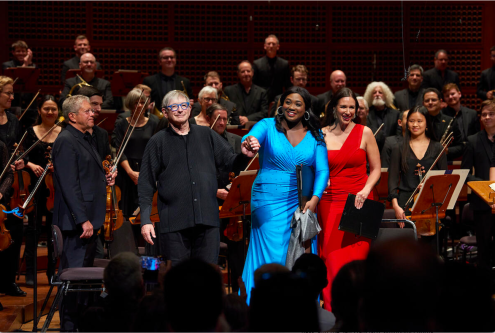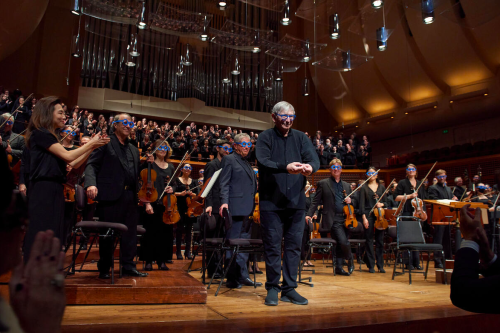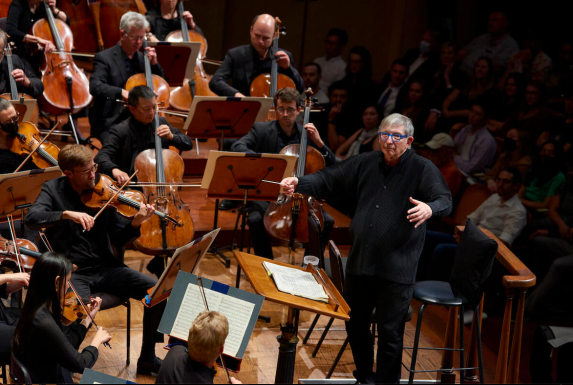 United States Beethoven, Symphony No.9 in D minor: Angel Blue (soprano), Tamara Mumford (mezzo-soprano), Ben Bliss (tenor), Dashon Burton (bass-baritone), San Francisco Symphony / Michael Tilson Thomas (conductor), San Francisco Symphony Chorus / Jenny Wong (director). Davies Symphony Hall, San Francisco, 19.10.2023. (HS)
United States Beethoven, Symphony No.9 in D minor: Angel Blue (soprano), Tamara Mumford (mezzo-soprano), Ben Bliss (tenor), Dashon Burton (bass-baritone), San Francisco Symphony / Michael Tilson Thomas (conductor), San Francisco Symphony Chorus / Jenny Wong (director). Davies Symphony Hall, San Francisco, 19.10.2023. (HS)
A tumultuous standing ovation greeted Michael Tilson Thomas on Friday evening as he made his way to the Davies Symphony Hall podium, slowly, carefully, with an aide trailing closely for safety. His response to this expression of love from the city’s classical music audience, nurtured by his 25-year tenure as music director, was a shy grin as he gripped an extra chair, strategically placed by the conductor’s spot.
The brain cancer that he has been living with, miraculously held at bay by leading-edge specialists, may have slowed his gait and robbed him of the physical vitality that always characterized his conducting style, but it hasn’t stopped him from making music with his home orchestra that can reach the sublime. As music director laureate, he has four concert programs scheduled for the 2023-2024 season, all aimed at some of the iconic pieces in the orchestral repertoire.
This was not Tilson Thomas’s most insightful interpretation of Beethoven’s Ninth Symphony. He chose slower-than-usual tempos for the first three movements, and seemed content not to introduce extra nuances that made his past performances here gripping from start to finish. However, the connection with the players in the orchestra was palpable, and the finale benefited from a starry cast and magnificent work from the Symphony Chorus, prepared by its new director, Jenny Wong.
The result was an emotionally fulfilling and musically exciting final 25 minutes. Tilson Thomas has the means in his bones to strike the necessary pace and balances in music that caroms from one extreme to another, as this finale does. It breathed with uncanny naturalness and reached climaxes that kept topping each other until the final iteration of the ‘Ode to Joy’ and the onrushing coda brought things to a peak.
From the opening measures, the music moved deliberately, without any sense of rushing, as did the second and third movements. Maybe that was intentional. A reflection of the angst we are feeling given the news from Ukraine and the Middle East? Perhaps. A tactic to make the finale all the more joyous? Maybe.
The dropping-fourths in the opening did not punctuate the mists as they usually do. It felt a bit restrained, allegretto rather than allegro. The pace did make it easier to follow Beethoven’s gradually increasing complexity, as did the less-than-vivace pace of the Scherzo that followed, which ambled along rather than pushing the tempo. Although the noble Adagio felt like less of a contrast after these interpretations, it savored the rich harmonies and long-limbed melody as beautifully as ever. Time seemed suspended, as it should.
The outburst at the beginning of the finale also took a slightly slower tempo than usual, but once the cellos and double basses interrupted the proceedings with their recitatives, the colors got more vivid and pulses quickened. Their first quiet statement of the ‘Ode to Joy’ could not have been more perfect, and when bass-baritone Dashon Burton threw down the long-awaited tune with nobility and, yes, tangible joy in the message of brotherhood, off we went.

Soprano Angel Blue and mezzo-soprano Tamara Mumford spun out the top-of-the-staff elaborations beautifully. Ben Bliss lent his liquid but substantial lyric tenor. The quartet was a marvel to hear, blending well and executing the coloratura cleanly.
The chorus was like another set of characters in an opera, the men delivering powerful exclamations, the women flying into the highest registers with expressiveness but without losing precision. Dynamics ranged from whispers to explosions. Every entrance was another revelation, and the climaxes thrilled to the bone.
As for the orchestra, they seemed to be aiming for a richer, rounder tone than their usual hi-fi qualities. The brass went for richness over power. The bassoons made their utterances bounce deftly and as mentioned, the cellos and double basses did their part with the big tune. At the center of it all was timpanist Edward Stephan. I never realized how busy the part is in this piece, but every time he punctuated a phrase it seemed to lift the music off the ground.

At the end, the audience stood again and roared with enthusiasm. The wide-eyed expressions and smiles of the soloists, the orchestra musicians and Tilson Thomas himself were something to behold. As they came out for second bows, it took the conductor a few beats to realize that the entire orchestra had donned blue eyeglasses like the ones he sports. Never one to miss a dramatic gesture, he grinned and slipped his own glasses down an inch to peer over them at the audience.
In a particularly touching moment, Blue and Mumford held Tilson Thomas’s hands and arms to walk him safely off the stage.
The conductor’s next appearance with this orchestra is scheduled for January: Beethoven’s Third Piano Concerto with Seong-Jin Cho and the Tchaikovsky Fourth Symphony. At this point, every time he conducts feels like a memorable occasion.
Harvey Steiman
